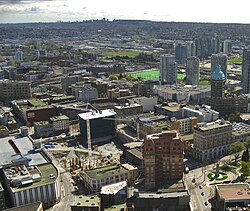Downtown Eastside
| Downtown Eastside | |
|---|---|
| Urban Neighbourhood | |

View of the Downtown Eastside and Woodward's site from Harbour Centre.
|
|
| Nickname(s): DTES, Skid Row | |
| Coordinates: 49°16′52.82″N 123°05′58.73″W / 49.2813389°N 123.0996472°WCoordinates: 49°16′52.82″N 123°05′58.73″W / 49.2813389°N 123.0996472°W | |
| Country |
|
| Province |
|
| City | Vancouver |
| Population (2011) | |
| • Total | 18,477 for the greater DTES area |
| • Estimate (2009) | 6,000 - 8,000 for the DTES |
| Time zone | PST (UTC-8) |
| • Summer (DST) | PDT (UTC-7) |
| Postal code | V6A |
| Area code(s) | 604, 778 |
The Downtown Eastside (DTES) is a neighbourhood in Vancouver, British Columbia, Canada. The area, one of the city's oldest, is notorious for its open-air drug trade, sex work, poverty, mental illness, homelessness, infectious disease, and crime. It is also known for its strong community resilience and history of social activism.
At the turn of the century, the DTES was the political, cultural, and retail centre of the city. Over several decades, the city centre gradually shifted westwards and the DTES became a poor, although relatively stable, neighbourhood. In the 1980s, the area began a rapid decline due to several factors including an influx of hard drugs, the de-institutionalization of mentally ill individuals, policies that pushed prostitution and drug-related activity out of nearby areas, and the cessation of federal funding for social housing. By 1997, an epidemic of HIV infection and drug overdoses in the DTES led to the declaration of a public health emergency. As of 2017, critical issues are an epidemic of fentanyl overdoses, a shortage of low-cost rental housing, and a high prevalence of severe mental illness which often co-occurrs with addiction.
The population of the DTES is estimated at around 6,000 to 8,000. Compared with the city as a whole, the DTES has a higher proportion of males, and of adults who live alone. It also has significantly more Aboriginals, who are further disproportionately affected by the neighbourhood's issues. The neighbourhood has a history of attracting individuals with mental health and addiction issues from across B.C. and Canada, with many drawn by its drug market, low-barrier services, and relatively affordable housing. Law enforcement policies are among the most progressive in Canada, however many vulnerable members of the community have low trust in police.
Numerous efforts have been made to improve the neighbourhood, at an estimated cost of over $1.4 billion as of 2009. Services in the greater DTES area are estimated to cost $360 million per year. Opinions vary on whether any progress has been made, and some commentators believe that residents of other neighbourhoods tacitly agree to have the area serve as a de facto ghetto for the most troubled individuals in the region. Parts of the area have begun to undergo gentrification, a trend that some see as a force for revitalization, but that others believe has led to displacement and homelessness. Proposals for addressing the issues of the area include increasing investment in social housing, increasing capacity for treating the addicted and mentally ill, making services more distributed across the city and region instead of concentrated in the DTES, and improving co-ordination of services. However, little agreement exists between the municipal, provincial, and federal governments regarding long-term plans for the area.
...
Wikipedia

